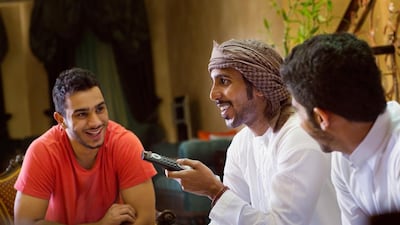Arab television series, known as Musalsalat, which air during Ramadan have gained in popularity over the past decade across the Arab world, bringing families together after iftar.
It is during the month of Ramadan that millions of Muslims and non-Muslims enjoy the melodramatic series that often feature historical or religious figures, but also intriguing love stories. Arab satellite TV channels run one episode per day throughout the holy month until the Arab world holds its breath for the finale, which is broadcast on Eid Al Fitr.
Post-iftar entertainment started with Hakawatis, storytellers who traditionally recounted tales and myths on Ramadan nights, whether in homes or in coffee shops. People would gather around them, enthralled as the Hakawati acted out the characters.
At the end of the 1970s and throughout the 1980s, Egyptian TV produced Fawazeer Ramadan (Ramadan Riddles), which first aired on radio before its transfer to television.
In the 1990s, telenovelas imported from South America captivated television viewers across the Arab world.
As Arab satellite channels emerged in the mid-1990s, Egyptian Musalsalat became popular in the region, and shows such as Aaylat Al Hajj Metwalli (The Family of Al Hajj Metwalli) aired during Ramadan, setting a precedent that has carried forward to today.
But it was the expansion of Arabic satellite channels that really solidified the tradition. In the 2000s, these channels poured money into their Ramadan offerings, creating shows with very high production values. Syrian soap operas, such as Bab Al Hara (The Neighbourhood’s Gate), played a central role in the emergence of the modern form of Musalsalat. Since the beginning of the conflict in Syria, other countries of the region, mainly Kuwait, the UAE and Jordan, have emerged to take Syria’s place as major producers of Ramadan series.
The UAE has its own favourites. In 2016, Khiyanat Watan (Betrayal of a Homeland), was the first political series to get such a wide audience.
It dealt with a sensitive political issue – the inner workings of the Muslim Brotherhood – and was enormously popular.
The show proved that difficult, sensitive topics could make for popular television. This year, Al Gharabeeb Al Soud (Black Crows) will come to the small screen, delving into the rise of extremism in the region from a female perspective.
Musalsalat are now seen as a means to raise awareness on several sensitive social and political issues, and have turned into big-budget series.
They offer a chance for television channels to rewind the clock to the days when audiences routinely used to sit down to watch a show when it is originally broadcast, no small feat in an entertainment landscape fractured by Netflix, YouTube and other streaming options.
By combining controversial topics with high production values – and often an all important love story – Musalsalat have become a staple of Ramadan across the Middle East, as much a family tradition as the daily breaking of the fast.

